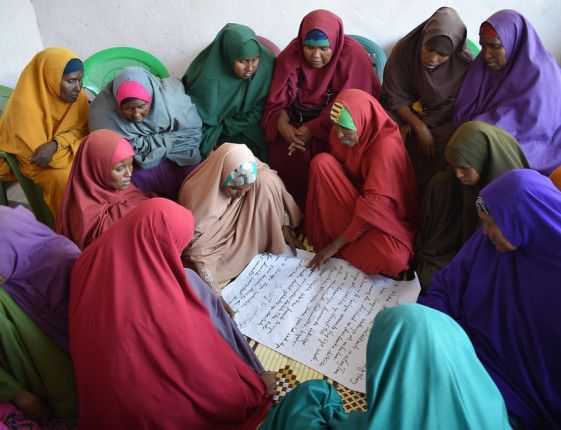-
The Risks of Gender-blind Climate Action
May 10, 2022 By Marisa O. Ensor
Climate change is widely recognized as one the greatest threats to peace and security in the 21st century. The causal pathways that link deteriorating environmental conditions, insecurity, and conflict, while seldom automatic or linear, are, nevertheless, ubiquitous. The adverse impacts of climate change exacerbate other risk factors, especially in already fragile contexts. In turn, these factors magnify pre-existing economic, social, or political drivers of insecurity.
Women and girls, and members of already vulnerable populations are thus placed on the frontlines of multiple and interrelated crises. The intersection of gender and other dimensions of identity plays a critical role in determining how people experience, respond to, and recover from the adverse effects of climate change. Compounded security and climate-related risks also are more likely to magnify challenges related to governance, entrench gender inequalities, and deepen the marginalization of women and girls.
The various resolutions that collectively comprise the Women, Peace, and Security (WPS) framework have the potential to improve climate outcomes by promoting women’s engagement in addressing climate-related security risks. Yet this recent emphasis on women’s participation in matters of peace, security, and climate action, when not coupled with adequate protection measures, may place women at a heightened risk of domestic, sexual, and political violence. It has also resulted in the increasing number of unremunerated tasks and responsibilities known as the “feminization of burden.”
The Violence of Inequality
As the earth’s average temperature increases, rising sea levels, prolonged droughts, and more frequent and severe storms affect the lives and livelihoods of women and men in all corners of the globe. Extreme weather events have a greater impact on the poor and other vulnerable segments of the population, and even more so on those living in nations riven by conflict. Competition over resources such as water and land poses a serious geopolitical risk that can lead to armed conflicts whose disproportionate impact on women and girls is well documented.
This heightened vulnerability is, to be sure, not inherent; rather, it is structural and contextual— the result of gender inequalities in the political, social, and economic spheres as they intersect with other axes of social disadvantage, such as race/ethnicity, sexual orientation, and disability status. Persistent social norms of female subordination cause women and girls to be more exposed to gender-based violence, and girls to be less likely than boys to continue their education during and after both conflict and climate-related events.
Economic inequalities are also prevalent. Women in developing countries are more likely to work in the informal sector. The commonly-held global prerequisite of land tenure to participate in community natural resource decision-making also constraints women’s input, with 64 percent of women lacking equal land rights to men in practice. Limited access to financial resources, training and technology, and exclusion from political decision-making spheres at all levels are also common. Unequal power relations within families and communities further limit women’s opportunities to participate in local environmental governance. And at national and international levels, women continue to face glass ceilings that prevent them from reaching environmental leadership positions. Gender parity in national-level environmental decision-making is rare, and women constitute on average one-third of the employees of environmental ministries.
The myriad ways in which gender inequality constraints women’s lived experiences also hamper their resilience and adaptive capacity. In turn, this state of affairs adversely impacts their families and communities. A gender-blind approach that ignores diversity and inclusion weakens climate change adaptation and mitigation responses, and reduces the efficacy of climate policy. It also contributes to the further marginalization and harmful effects on women, girls, and other excluded groups, and may even lead to the resurgence of conflict.
Beyond the Participation-Protection Binary
A growing body of evidence from across the world demonstrates that the application of a gender perspective improves peace and security operations. While the WPS framework shines a welcome spotlight on the positive outcomes of women’s participation, this approach is not without critics.
The complex relationship between the “participation” and “protection” in the so-called “Pillars for Action” established by UNSCR 1325 is often insufficiently considered. The narrow focus on protection issues has concerned some observers, especially regarding sexualized violence in fragile contexts, which eclipses broader consideration of the structural and environmental violence that affects women’s lives. This critique perpetuates a false binary between the participation of women as leaders with agency and the protection of women as vulnerable victims. Moving beyond the oppositional politics of “protection versus participation” requires interrogating the links between participation and violence against those who do so.
In contexts of environmental (in)security, more specifically, recognizing women as powerful agents in inclusive climate action also necessitates a move beyond outdated “just add women and stir” models. The promotion of inclusive planning and action will ensure both the involvement and the protection of those who are most likely to suffer the negative effects of climate change. Such an approach must be transformative as well, and strengthen women’s strategic activism, capacity building, and resource access.
Among Indigenous women, as a case in point, participation in peace and environmental activism entails additional challenges, as it is often perceived as breaking both class and gender social norms. Indigenous women often see their struggle as both environmental and spiritual as they fight against the destruction of sacred sites in their territory. They have at times paid for their efforts with their lives, with the lethal attacks against them taking place in the context of wider threats including criminalization, intimidation, unlawful surveillance, and sexual violence. Yet, Indigenous women and human rights defenders across the globe are at the vanguard of land rights advocacy and environmental protection, demonstrating that vulnerability and resilience can happen simultaneously.
The Feminization of Burden
Owing to gendered social norms that view unpaid care work as a female responsibility, women across the world spend a disproportionate part of their day fulfilling domestic and reproductive roles. The levels of gender inequalities in unpaid domestic tasks may be universally prevalent, but they do appear to be related to the wealth of a country.
OECD time use data reveal a negative correlation between income and levels of gender inequalities in unpaid domestic roles—that is, the distribution of unpaid responsibilities is less unequal in high-income countries. This is generally attributed to men in these countries being generally more engaged in care activities. In developing countries and conflict zones, women and typically responsible for gathering and producing food, collecting water, and sourcing fuel for heating and cooking. Overdependence on these resources increases deforestation and puts women and their families at risk of exposure to smoke and fire hazards. Climate change is rendering these tasks increasingly difficult, dangerous, and time-consuming.
Additionally, unpaid care work is a major factor in determining both whether women enter and stay in paid employment and the quality of their work. The expectation that they will continue to carry out the bulk of unpaid domestic tasks while engaged in paid labor creates a “double burden” of work for women. This then becomes a “triple burden” when active participation in climate action and environmental governance are added to women’s plates.
As Mary Robinson has forcefully argued, climate action must be guided by a view of climate justice that mainstreams gender considerations and strives “to achieve a human-centered approach, safeguarding the rights of the most vulnerable and sharing the burdens and benefits of climate change and its resolution equitably and fairly.”
The Way Forward
The COVID-19 pandemic has exposed gender inequalities that are exacerbated in environmentally fragile and conflict-affected situations, and supply evidence for the continued relevance of the WPS Agenda. At the same time, the WPS community must contend with the reality that efforts to increase women’s visibility in public spaces often result in unintended but serious risks and challenges for the brave women who fulfill these roles.
Gender issues, climate change shocks and stressors, and security risks are all highly complex and deeply interconnected. It is imperative that we heed Chantal de Jonge Oudraat and Michael E. Brown’s exhortation to bring together scholars, policy experts, and policymakers working on the gender-climate-security “triple nexus” if these interrelated threats to human and planetary security are to be resolved.
Despite being underrepresented in environmental decision-making at all levels, women—and especially indigenous women and those living in the global south—are leading frontline climate action and activism. Interventions around natural resources, environment and climate change provide significant opportunities to empower women politically and economically, and to strengthen their contributions to conflict prevention and peacebuilding in conflict-affected countries. We must find ways to promote their meaningful participation without increasing their already disproportionate burdens or exposing them to unnecessary risks.
Marisa O. Ensor is an applied environmental and legal anthropologist currently based at Georgetown University’s Justice and Peace Studies Program.
Sources: United Nations; SIPRI; International Union for Conservation of Nature; Mercy Corps; World Economic Forum; Indian Journal of Community Medicine; Conflict and Health; Refuge; WIEGO; LandLinks; Our World in Data; Friedrich-Ebert-Stiftung; World Bank; E-International Relations; The Oxford Handbook of Women, Peace, and Security; Parameters; The New Humanitarian; OECD; The Conversation; WHO; International Labour Organization; International Women’s Development Agency; Empower Women; Mary Robinson Foundation; International Peacekeeping; Wilson Center; Georgetown Institute for Women, Peace and Security.
Image Credit: Women from conflicting clans in Somalia who have experienced years of conflict, marginalization and drought develop a plan for their district, courtesy of Flickr user USAID.
 A Publication of the Stimson Center.
A Publication of the Stimson Center.






